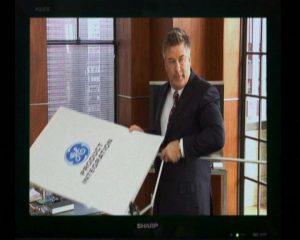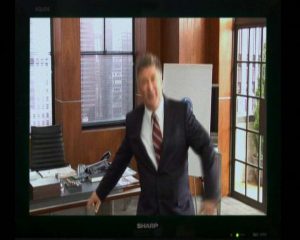Having previously considered the ways in which Alec Baldwin has his character Jack Donaghy run through the gamut of bad actor behaviour and bad acting in the 30 Rock (NBC 2006-2013) episode ‘Jack-Tor’ (1.5), it is now time to address the question previously raised by Martin Esslin: ‘How, in fact, does a good actor act a bad actor?’ (1987: 72) In this follow-up, we will examine the ways in which Baldwin delivers his masterclass on bad acting through use of sharp timing, precise vocal control, nuanced physical expression as well as through ‘being in the moment,’ which facilitates the illusion of the first time.
Within the rapidly cut ‘outtakes’ sequence, [1]This sequence can be found from 10.26-12.41 on the relevant DVD, and extracts can be enjoyed here and here. Baldwin’s assured use of timing is readily detectible, both in terms of his speed of delivery and his use of pauses. During his moments of rude procrastination, Baldwin’s Jack has a production assistant give him the line (which he has failed to learn), and when the assistant inevitably obliges, Jack responds by interjecting that the assistant say it louder. Here, the quickness of his response is noteworthy, for its almost instantaneous delivery reveals that Jack had already decided that he would not be satisfied with the assistant’s efforts, using his power status to distract from his own struggles. Then, Jack decides that he will be able to remember his script via shorter prompts and – like a professional actor would – asks for the first word of the line. Baldwin responds to hearing the prompt (‘product’) with a pause, during which he looks to his left, blinks and then finally needs to ask for the second word (‘integration’) after all.

What is the word?: Alec Baldwin’s sharp timing makes effective use of pauses
Here, the delay, despite and because of the silence and stillness, speaks volumes: through the pause, Baldwin signals that his character is trying (although not too hard) and failing to remember the line, before finally admitting his need for further help. Externalising his character’s thought process through the small movement of his eyes and eyelids and the look on his face, Baldwin times the length of the pause very effectively: it is too short to contain a committed attempt to remember for Jack; but it is long enough to imply the futility of Jack’s effort – the implication of the vacant look held on Jack’s face is that he is drawing a complete blank – and allows Jack to pretend otherwise (i.e. that he has properly tried to search his memory). In addition, the pause is also long enough to make the viewer, who likely suspects that Jack won’t be able to deliver the line (even though he has heard it repeatedly), wonder what Jack’s response might be; and the banality and ultimate inevitability of the request for the second word underscores the comedy.
This precise use of timing is complemented and supported by Baldwin’s use of his voice and body. That Baldwin – unlike Jack, who fumbles some of his lines with poor diction – possesses excellent vocal control and is particularly adept at modulating the pitch, register and texture of his voice is knowingly drawn upon in his appearance in the 2016 BT Mobile commercial campaign, which riffs on the mobile provider’s service being ‘as good as Alec Baldwin’s dramatic delivery’, as well as in Jack’s use of accents during a role-play therapy session with Tracy Jordan (Tracy Morgan) in the acclaimed 30 Rock episode ‘Rosemary’s Baby’ (2.4). [2]Baldwin’s gift for accents can also be enjoyed here and here. Baldwin’s skilled use of voice is subtly evident in the ‘outtakes’ sequence, for example, when his barked instruction at another production assistant to not give him the line when he asks for it shows that this too is a premeditated response. Baldwin manages to signal this not only through once more making use of quick timing, but also through the fact that his voice stays within the same pitch. Surely, were his character less preoccupied with laying a trap for the production assistant, and instead more genuinely engaged in the frustrated attempt to remember the line, then unpremeditated exasperation would have affected his pitch (for example, he could have snapped harder).

‘I told you, ‘Don’t give me the line when I ask for the line!’: Baldwin’s precise vocal control underscores the game he plays with the production assistant
In contrast, Jack’s pivotal question, ‘It’s weird; what do I do with my arms?’, has him varying his pitch within the octave, placing effective emphasis on the word ‘arms’ through elongation and adding a sonorous texture to his voice. As we have previously discussed, this pivotal question encapsulates the self-conscious physical awkwardness experienced and suffered by Jack in front of the camera. What is important to highlight here is that Baldwin does not express that awkward physicality simply through, for example, as previously noted, walking with a stiff gait without counterbalancing arm-swing, or an overly smooth gait lacking natural bounce, or through holding a mug in each hand. Although these acting choices in themselves would already be noteworthy, Baldwin lifts these moments to a higher level of performance achievement by adding small physical touches and inflections to each.


By George, he thinks he’s got it!:Jack believes he has nailed the acting challenge of walking
So, when his character first walks with a stiff, robotic gait, Baldwin looks down with a concentrated look on his face, indicating that Jack is analysing (and indeed over-thinking) the act of placing one foot in front of the other. Then, when Jack walks without natural bounce in the next shot, Baldwin holds his torso very upright and still, swinging his arms just a touch higher than one would expect from natural movement. Coupled with a direct, almost defiant look into the camera and framed by his utterance ‘Or, if I may….’, Baldwin’s gliding semi-strut here suggests that his character believes that, through his analysis of the act of walking, he has cracked the acting challenge of producing a realist and invisible performance. Jack Donaghy believes he knows ‘how to walk, and sit, and talk, and watch’ (Stanislavski cited in White 2014: 299) not only in life, but now also in front of the camera; and it appears that to him here, the question is not so much the Stanislavskian ‘Why are they looking at me?!’, but more ‘Why wouldn’t they be looking at me?!’

Why wouldn’t you be looking at him?
Jack’s feelings of confidence, however, prove ephemeral: while his ingenious solution to the acting challenge of what to do with his arms sees him hold a mug in each hand, Baldwin again uses physical nuance to layer meaning. He has his elbows pulled quite close to his torso and holds the mugs a little too close to his body. This brings to mind not only the notion of protective armour, but also, through the previous double-handed grasping for something to hold, the image of a small child clutching a toy. This connotation of childlikeness (if not childishness) is further developed in Baldwin’s use of the display prop board. Because he awkwardly carries the prop in such a way that gravity, his own bodily momentum and the prop’s weight and shape work against him, his walk becomes reminiscent of the waddle of a toddler. Because Jack clumsily knocks the board over – the humour here stems from the incongruity of the energy of the gesture: why would Jack turn the page that forcefully? – his gesturing somewhat evokes a child knocking into its toys or throwing them around. With the fictional shoot steadily disintegrating and amassing what would become a total of 142 takes, Baldwin’s subtle physical choices articulate that his normally so confident character Jack is regressing in this emasculating experience of embarrassment and incompetence.



The acting adage ‘Learn your lines and don’t bump into the furniture’ proves a challenge for the rapidly regressing Jack – as it would for any toddler
Most importantly, perhaps, Baldwin’s successful performance of Jack’s bad acting hinges around the notion of ‘being in the moment’, a state of unselfconscious, relaxed concentration – in Stanislavskian terms, a state of ‘public solitude’ in which, as Sharon Marie Carnicke notes, ‘actors tune out anything external to the world of the play’ (2010: 9) – which Jack fails but Baldwin manages to reach. In those moments when Jack is not delivering a performance to the fictional camera, his physicality and use of voice instantly become more natural. Baldwin performs Jack’s shifting into and out of producing a visible performance within Baldwin’s own overall performance remaining invisible: the character moves between looking like he is acting and like he is not acting, but at no point does it look like Baldwin is acting. These gear changes and layered tension are a difficult performance challenge; one that Baldwin manages through his own organic absorption in the moment, where, unlike the character he plays, he is not distractible or self-consciously analysing himself.

The harder they fall: drawing on strong technique, Baldwin is in the moment
Baldwin’s being in the previously mentioned ‘state of I am’ (Whyman 2008: 254, original emphasis) is strongly evident in the moment of Jack’s slapstick backward fall, during which Baldwin does not stop smiling until after he has started to fall. There is no trace of premeditation here, reflecting his and his character’s absorption in the moment. Had he broken his smile before moving backwards, it would have spoiled the idea that Jack had accidentally misjudged the distance between himself and the desk. [3]It is worth noting that the ‘outtakes’ sequence highlights Baldwin’s physical skill by showing, without cutting away, that Baldwin falls well, drawing on his actor training to produce a fall … Continue reading That Baldwin manages ‘to experience’ (Whyman 2008: 254, original emphasis) also informs the pause preceding the request for the second word, discussed above. The movement of his eyes, including the blink, as well as the slight affirmative nod of his head, happen organically; here Baldwin is in the moment while Jack is self-consciously struggling with his lines.
Unlike Jack, Baldwin reaches a level of immersion into the moment, which helps him produce ‘the illusion of the first time,’ a significant challenge for screen and stage actors working within realism articulated by William Hooker Gillette in 1915. Gillette wrote:
Unfortunately for an actor (to save time I mean all known sexes by that), unfortunately for an actor he knows or is supposed to know his part. He is fully aware […] of what he is going to say. The character he is representing, however, does not know what he is going to say, but, if he is a human being, various thoughts occur to him one by one, and he puts such of those thoughts as he decides to, into such speech as he happens to be able to command at the time. Now it is a very difficult thing […] for an actor who knows exactly what he is going to say to behave exactly as though he didn’t; to let his thought (apparently) occur to him as he goes along, even though they are there in his mind already; and (apparently) to search for and find words by which to express those thoughts, even though these words are at his tongue’s very end. (in Cole and Chinoy 1974: 564-565)
Baldwin makes it seem as though Jack is experiencing the specific moments and struggles in the ‘outtakes’ sequence for the first time. His character should, but does not quite have the fictional script ‘at his tongue’s very end.’ He should also have his own (within the fiction, unscripted) words not at his tongue’s very end, except for the moments of premeditation when Jack is playing games with the production assistants. Baldwin himself, however, has to have none of the words he utters appear as though they are at his tongue’s very end. He has to fall spontaneously, has to experience the pause, has to let his character’s fictionally unscripted thoughts and words occur to him as he goes along (e.g. his exclamation ‘intergortion?’). In a sequence that in actuality was likely shot via a mix of improvisation and repeated takes, Baldwin’s challenge of the illusion of the first time here is inflected and increased through the play with premeditation that works on the level of character and not actor.
To return to the question ‘How, in fact, does a good actor act a bad actor?’ (Esslin 1987: 72), we hope our discussion has demonstrated that the answer is not ‘through acting badly’. With reference to Laurence Olivier’s performance as Archie Rice in John Osbourne’s The Entertainer (1957), Esslin himself proposed:
So the actor has to show the audience that he is fully in command of the situation. He must, in fact, make the audience aware the he knows how to do all the things he does badly, very well. He achieves this through his timing, the obviousness of the excessive delay with which he brings the point of the joke, the sureness of touch by which he puts his foot wrong in the tap-dancing routine, the slight flicker of terror in his eyes when it goes wrong, designed to make it clear that he is doing it wrong with premeditation – which, of course, requires even greater skill than doing it just right. (1987: 72)
Esslin’s comments pertaining to being in command, timing, sureness of touch and the importance of nuanced performance very much apply to Alec Baldwin’s work. There is, however, no obviousness or excessiveness to his choices here; the performative framing that Esslin refers to for Olivier’s stage-based performance is instead provided by the cutting and non-diegetic music of the ‘outtakes’ sequence, which make it clear that Baldwin ‘is doing it wrong with premeditation’. This allows the premeditation to read on the level of character and not actor, allowing Baldwin to stay deadpan and ‘straight’.
Of course, the overall framing of Baldwin’s and Jack’s acting within the ‘outtakes’ sequence, which contrasts sharply with the ‘resulting’ corporate video, in which Jack delivers a convincing performance, provides a further meta commentary on acting. Bringing to mind the infinite monkey theorem, this commentary reflects that even acting as bad as Jack’s may be rescued through careful (and patient) direction and post-production. [4]Later within ‘Jack-Tor’, Jack sufficiently overcomes his life-long struggles with live performance to be able to act on the show-within-the-show TGS with Tracy Jordan thanks to a ‘tough love’ … Continue reading As Richard Hewett notes, ‘[t]he repeated-take nature of single camera recording means that performance can be pieced together in post-production, mediated by the employment of editing, sound effects and music.’ (2015: 79) This symbiotic relationship between screen acting and other components of pre-production, production and post-production is part of why acting has not been given as much attention and recognition as it deserves (see also Robertson Wojcik 2004). Nevertheless, even within the rapidly cut ‘outtakes’ sequence, Baldwin’s skill and ability shine through. Just as ‘30 Rock positions itself next to TGS as an example of bad television to assert 30 Rock’s quality as good television’, so Baldwin here positions himself next to Jack as an example of bad acting to assert his quality as a very good actor indeed.
Gary Cassidy is Lecturer in Acting at Bath Spa University. He is currently completing AHRC-funded doctoral research at the University of Reading, which explores the rehearsal process of playwright Anthony Neilson, using filmed footage of rehearsals and interviews. He trained as an actor at the Royal Scottish Academy of Music and Drama and has many years of professional acting experience – Equity name Cas Harkins – covering film, theatre, television and radio. Plans for future research focus on using his research methodology to explore the working processes of other contemporary theatre practitioners.
Simone Knox is Lecturer in Film and Television at the University of Reading. Her research interests include the transnationalisation of film and television (including audio-visual translation), aesthetics and medium specificity (including convergence culture), and representations of the body and identity. She sits on the board of editors for Critical Studies in Television and her publications include essays in Film Criticism, Journal of Popular Film and Television and New Review of Film and Television Studies.
Works Cited
Carnicke, Sharon Marie. 2010. ‘Stanislavsky’s System: Pathways for the Actor’ In Actor Training, second edition, edited by Alison Hodge, 1-25. London; New York: Routledge.
Cole, Toby and Helen Krich Chinoy (eds). 1974. Actors on Acting. New York: Crown Publishers.
Esslin, Martin. 1987. ‘Actors Acting Actors’. Modern Drama 30 (1): 72-79.
Hewett, Richard. 2015. ‘The Changing Determinants of UK Television Acting’. Critical Studies in Television 10 (1): 73-90.
Robertson Wojcik, Pamela. 2004. ‘General Introduction’. In Movie Acting, The Film Reader, edited by Pamela Robertson Wojcik. 1-13. New York; London: Routledge.
Patterson, Eleanor. 2013. ‘Shut it Down: The End of 30 Rock’. Antenna. Accessed 6 January 2017. http://blog.commarts.wisc.edu/2013/02/25/shut-it-down-the-end-of-30-rock/
White, R. Andrew. 2014. ‘Stanislavsky and Ramacharaka: The impact of yoga and the Occult Revival on the System’. In The Routledge Companion to Stanislavsky, edited by R. Andrew White, 287-304. London; New York: Routledge.
Whyman, Rose. 2008. The Stanislavsky System of Acting: Legacy and Influence in Modern Performance. Cambridge: Cambridge University Press.
References
| ↑1 | This sequence can be found from 10.26-12.41 on the relevant DVD, and extracts can be enjoyed here and here. |
|---|---|
| ↑2 | Baldwin’s gift for accents can also be enjoyed here and here. |
| ↑3 | It is worth noting that the ‘outtakes’ sequence highlights Baldwin’s physical skill by showing, without cutting away, that Baldwin falls well, drawing on his actor training to produce a fall that looks painful without hurting himself. This is a good example of how strong technique can aid unselfconscious, organic absorption: because Baldwin knows that he knows how to fall, the fall does not pose a distraction to him. |
| ↑4 | Later within ‘Jack-Tor’, Jack sufficiently overcomes his life-long struggles with live performance to be able to act on the show-within-the-show TGS with Tracy Jordan thanks to a ‘tough love’ pep talk by Liz Lemon (Tina Fey), who insists that ‘any dum-dum can act, Jack’. |




